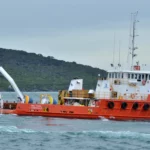The maritime industry is constantly evolving, driven by an increased focus on safety and compliance. As such, the role of regulatory bodies like the Australian Maritime Safety Authority (AMSA) has never been more important. In this article, we will explore how AMSA regulations are shaping the future of compliance and maritime safety.
With an emphasis on protecting the environment, ensuring workplace safety, and safeguarding the lives of those at sea, AMSA regulations are designed to create a safer and more efficient maritime industry. These regulations cover a wide range of areas, including vessel operations, crew training, and emergency preparedness.
By adhering to AMSA regulations, shipowners and operators are not only avoiding costly penalties but also demonstrating their commitment to the highest standards of safety and environmental responsibility. As the maritime industry continues to grow, compliance with AMSA regulations will become even more critical.
In this article, we will delve deeper into how AMSA regulations are influencing the industry, the challenges they present, and the opportunities they bring. Join us as we explore the future of compliance and the impact it will have on maritime safety.
The Importance of Compliance in the Maritime Industry
Compliance is of utmost importance in the maritime industry. The nature of maritime operations poses unique risks and challenges, making it crucial for shipowners and operators to adhere to regulations that ensure safety and protect the environment. AMSA regulations play a vital role in achieving these objectives.
One key aspect of compliance is the protection of the marine environment. AMSA regulations require vessels to adhere to strict standards to prevent pollution and minimize the impact on marine ecosystems. These regulations cover areas such as ballast water management, emissions control, and waste disposal. By complying with these regulations, shipowners contribute to the preservation of marine biodiversity and the sustainability of the maritime industry.
Another crucial aspect of compliance is ensuring workplace safety. Maritime operations can be hazardous, and the well-being of crew members is of paramount importance. AMSA regulations set standards for crew training, safety equipment, and emergency preparedness. By adhering to these regulations, shipowners create a safe working environment and reduce the risk of accidents and injuries at sea.
Additionally, compliance with AMSA regulations is essential for the prevention of maritime incidents and accidents. These regulations cover various aspects of vessel operations, including navigation, manning, and maintenance. By ensuring compliance, shipowners minimize the risk of incidents that could result in the loss of lives, damage to property, or harm to the marine environment.
Compliance with AMSA regulations not only mitigates risks but also enhances the reputation and credibility of shipowners and operators. By demonstrating a commitment to safety, environmental responsibility, and regulatory compliance, maritime businesses can build trust with stakeholders and attract potential customers who prioritize these values.
Key AMSA Regulations and Their Impact on Maritime Safety
AMSA has implemented several key regulations that have a significant impact on maritime safety. These regulations cover a wide range of areas, ensuring that all aspects of vessel operations are conducted in a safe and compliant manner.
1. Crew Training and Certification: AMSA regulations require crew members to undergo rigorous training and certification programs to ensure they possess the necessary skills and knowledge to perform their duties safely and effectively. These regulations cover areas such as firefighting, first aid, navigation, and emergency response. By setting high standards for crew training, AMSA ensures that vessels are manned by competent and capable individuals.
2. Vessel Inspection and Maintenance: AMSA regulations mandate regular inspections and maintenance of vessels to ensure their seaworthiness. These regulations cover areas such as hull integrity, machinery, navigation equipment, and safety systems. By conducting thorough inspections and implementing proper maintenance practices, shipowners can identify and rectify potential issues before they escalate into major safety hazards.
3. Emergency Preparedness: AMSA regulations require vessels to have comprehensive emergency response plans in place. These plans outline procedures for various emergency scenarios, including fire, collision, grounding, and man overboard situations. By having well-defined emergency response plans, shipowners can ensure that their crew members are prepared to handle emergencies effectively, minimizing risks to life, property, and the environment.
4. Pollution Prevention: AMSA regulations place a strong emphasis on pollution prevention and control. These regulations cover aspects such as ballast water management, fuel oil consumption, and waste disposal. By implementing measures to prevent pollution, such as using environmentally friendly technologies and complying with discharge limits, shipowners contribute to the preservation of marine ecosystems and the reduction of environmental impact.
The impact of these regulations on maritime safety is significant. By setting standards and requirements for crew training, vessel maintenance, emergency preparedness, and pollution prevention, AMSA ensures that vessels operating in Australian waters are safe, efficient, and environmentally responsible.
Advances in technology, such as the use of automation, drones, and artificial intelligence, are driving compliance in the maritime industry. These technological advancements enable shipowners and operators to streamline compliance processes and enhance safety measures.
Challenges and Opportunities in Implementing AMSA Regulations
While AMSA regulations are crucial for maritime safety, they also present challenges for shipowners and operators. Compliance with these regulations requires significant investments in terms of time, resources, and training. In many cases, existing vessels need to be retrofitted or upgraded to meet the new standards, which can be costly.
Additionally, the maritime industry is global in nature, with vessels trading internationally. This presents challenges in terms of harmonizing regulations and ensuring compliance across different jurisdictions. Shipowners and operators need to navigate through a complex web of regulations to ensure they meet the requirements of multiple regulatory bodies.
However, despite these challenges, implementing AMSA regulations also presents opportunities for maritime businesses. By proactively embracing compliance, shipowners and operators can gain a competitive edge in the industry. Compliance with AMSA regulations demonstrates a commitment to safety, environmental responsibility, and operational excellence, which can attract customers who prioritize these values.
Furthermore, compliance with AMSA regulations can lead to improved operational efficiency. By adhering to best practices and implementing advanced technologies, shipowners can optimize their vessel operations, reduce fuel consumption, and minimize downtime due to maintenance issues. This not only enhances safety but also improves the profitability and sustainability of maritime businesses.
The Role of AMSA in Enforcing Compliance and Ensuring Maritime Safety
AMSA plays a crucial role in enforcing compliance with regulations and ensuring maritime safety. As the regulatory body responsible for maritime safety in Australian waters, AMSA has the authority to conduct inspections, audits, and investigations to ensure that vessels and their operators comply with the applicable regulations.
AMSA carries out regular inspections of vessels to assess their compliance with safety and environmental standards. These inspections may be scheduled or carried out at random to ensure that shipowners are maintaining the required level of compliance at all times.
In cases of non-compliance, AMSA has the power to issue penalties, fines, or even detain vessels until necessary improvements are made. These enforcement measures are essential in maintaining a high level of safety and compliance across the maritime industry.
AMSA also provides guidance and support to shipowners and operators to help them understand and meet the requirements of the regulations. Through workshops, training programs, and information resources, AMSA aims to promote a culture of compliance and continuous improvement in the industry.
Case Studies Showcasing the Positive Impact of AMSA Regulations
Several case studies highlight the positive impact of AMSA regulations on maritime safety. These real-life examples demonstrate how compliance with AMSA regulations can prevent accidents, protect the environment, and save lives.
One such case study involves a cargo vessel that experienced an engine room fire while sailing in Australian waters. Thanks to the crew’s thorough training in firefighting techniques, they were able to quickly extinguish the fire and prevent it from spreading, minimizing damage to the vessel and avoiding any injuries or loss of life. This incident showcases the importance of crew training and emergency preparedness in ensuring the safety of both the vessel and its crew.
Another case study involves a tanker that was found to be non-compliant with ballast water management regulations during an AMSA inspection. The vessel was promptly detained until the necessary measures were taken to rectify the issue. This case study highlights the effectiveness of AMSA’s inspection and enforcement processes in ensuring compliance with environmental regulations.
These case studies demonstrate that compliance with AMSA regulations is not only a legal requirement but also a crucial factor in preventing accidents, protecting the environment, and ensuring the safety of maritime operations.
Future Trends and Predictions for Compliance in the Maritime Industry
Looking ahead, compliance in the maritime industry is expected to undergo significant changes and advancements. Several trends and predictions can be identified, indicating the direction in which compliance is heading.
One key trend is the increasing use of digital technologies and data analytics in compliance management. Shipowners and operators are adopting digital solutions to streamline compliance processes, monitor vessel performance, and analyze data for predictive maintenance and risk management. These technologies enable real-time monitoring and reporting, enhancing safety and efficiency while reducing administrative burdens.
Another trend is the growing focus on sustainability and environmental responsibility. Regulatory bodies, including AMSA, are placing greater emphasis on reducing carbon emissions, improving fuel efficiency, and minimizing the environmental impact of maritime operations. Compliance with these regulations will require a shift towards cleaner fuels, energy-efficient technologies, and sustainable practices.
Additionally, harmonization of regulations across different jurisdictions is expected to gain momentum. Efforts are being made to align international regulations and standards to create a more consistent and unified approach to compliance. This will simplify the compliance process for shipowners and operators, reduce administrative complexities, and facilitate international trade.
Furthermore, the adoption of risk-based approaches to compliance is likely to increase. Rather than a one-size-fits-all approach, regulations may be tailored to address specific risks and vulnerabilities. This will allow shipowners and operators to allocate resources more effectively and focus on areas that pose the greatest risks.
Compliance Strategies for Maritime Businesses to Stay Ahead of AMSA Regulations
To stay ahead of AMSA regulations and ensure compliance, maritime businesses can adopt several strategies:
1. Stay Informed: Keep up-to-date with the latest regulations and amendments issued by AMSA. Regularly review the AMSA website, subscribe to industry newsletters, and attend relevant workshops and conferences to stay informed about compliance requirements.
2. Invest in Training: Prioritize crew training and ensure that all personnel possess the necessary certifications and competencies required by AMSA regulations. Regularly conduct training programs and drills to maintain and enhance crew skills.
3. Implement Technology: Embrace digital solutions and technologies that can streamline compliance processes and enhance safety measures. Explore options such as onboard monitoring systems, predictive maintenance software, and data analytics tools to optimize vessel operations.
4. Engage in Continuous Improvement: Establish a culture of continuous improvement by conducting regular audits and assessments of vessel operations. Identify areas for enhancement and implement corrective actions to ensure ongoing compliance with AMSA regulations.
5. Collaborate with Industry Stakeholders: Engage with industry associations, classification societies, and other stakeholders to exchange knowledge and best practices. Collaborate on initiatives that promote safety, environmental responsibility, and compliance in the maritime industry.
By implementing these strategies, maritime businesses can position themselves as leaders in compliance and ensure the safety and sustainability of their operations.
Conclusion: Embracing the Future of Compliance in the Maritime Industry
The future of compliance in the maritime industry is shaped by AMSA regulations, which prioritize safety, environmental responsibility, and operational excellence. Compliance with these regulations is crucial for shipowners and operators to ensure the safety of their vessels, protect the marine environment, and demonstrate their commitment to the highest standards of maritime operations.
Despite the challenges that compliance may pose, embracing AMSA regulations presents opportunities for maritime businesses to gain a competitive edge, improve operational efficiency, and enhance their reputation. By staying informed, investing in training, leveraging technology, engaging in continuous improvement, and collaborating with industry stakeholders, shipowners and operators can navigate the evolving regulatory landscape and ensure compliance with AMSA regulations.
As the maritime industry continues to evolve, compliance will remain a fundamental aspect of maritime operations. By embracing the future of compliance and proactively adhering to AMSA regulations, maritime businesses can contribute to a safer, more sustainable, and more efficient industry. Let us embrace the future together and create a maritime world that prioritizes safety, compliance, and excellence.
Discover how Sea-Flux Vessel Management Software can be your ultimate partner in achieving seamless compliance for commercial vessel operations. Whether you’re a ship owner, operator, or manager, our cutting-edge solutions are tailored to simplify compliance processes and enhance safety standards, maintenance and efficiency.








